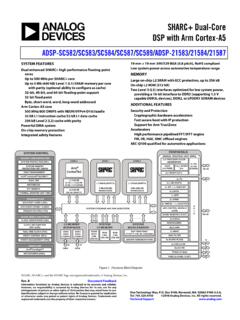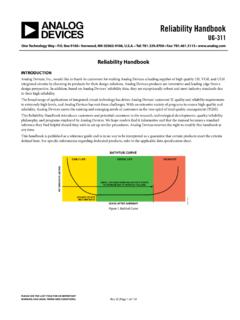Transcription of IFR GPS REGULATIONS
1 IFR Refresher January 2010 REGULATORY REVIEWIFR REFRESHERREADER SERVICES:FOR BACK ISSUES, ARTICLES:Phone us at:(20 ) 8 - 14 Fax us at:(20 ) 8 - 10 FOR QUESTIONS ABOUT YOUR SUBSCRIPTION:Please call (800) 82 - 1 or mail us atIFR BOX 4202 PALM COAST, FL 2142-02 TO CHANGE YOUR ADDRESS:Attach your present mailing label to this form (or a copy of this form), enter your new address below and mail to:IFR BOX 4202 PALM COAST, FL 2142-02 Name_____Company_____Address_____Address 2_____City_____State_____ ZIP_____E-mail_____TO ORDER OR RENEW A SUBSCRIPTION: Enter your name and address above and check the subscription term that you prefer: 1 year (12 issues) $ months ( issues) $ 0 For all other countries:1 year, US $ ; months, US $ Check enclosed AMEX MasterCard VISACard #_____Expiration Date_____Signature_____IFR GPS REGULATIONST here aren t a lot and they seem to be written with common sense in mind.
2 Here s a concise review of the REGULATIONS for using GPS to fly Fred SimondsFortunately for those of us looking to the future of IFR, the rules for operating under IFR with GPS are not terribly lengthy and are largely based on a pleasant amount of common sense. Here s a thumbnail look at the current BasicsAny approach procedure you want to fly must be retrievable from the current airborne navigation database which is updated every 28 days. It has to say GPS in the title of the proce-dure, otherwise you have to fly it as a conventional approach between the FAF and MAP. You can t make up your own approaches, nor can you edit the ones in the database. Because there is the chance that your database will expire when you are traveling somewhere that you can t arrange for the update, carry a paper backup.
3 Of course nothing can go wrong, can go wrong..While it is not legal for approaches, you can use an expired database for en route and terminal operations, as long as you verify the data is still correct, generally by reference to paper charts. For approaches, you are required to use paper and not the expired data-base. While you are not required to carry paper charts, putting all your eggs in the one database basket just seems a little optimistic. In-f light, and especially on approaches, verify that the database waypoints can also be identified on the procedure chart. Small differences in spelling matter less than being logi-cally located, in correct order, and ori-ented to each other as on the procedure chart, laterally and Dilemmas Naming inconsistencies between data-bases, including those of approaches and navaids are common because the data comes from many sources and passes through several manipulators.
4 In further fact, the presentation to you is not standardized; it s up to the manufacturer even though the under-lying data itself is standard. If there is significant difference between what you see in the database and on the paper chart, don t fly the procedure until you sort it remaining, and nagging incon-sistency between databases is course information. This is due to differences in the way magnetic variation is com-puted within the GPS receiver and the approach plate. Most GPS receivers use a dynamic magnetic variation algorithm based on interpolating lines of variation. The differences should be negligible, but in every case the published approach plate and its associated NOTAMs, if any, take can t make up your own approaches, nor can you edit the ones in the database.
5 IFR Refresher January 201010 REGULATORY REVIEWR eceiver SubstitutionIt is legal for you to substitute your IFR en route and terminal GPS, as well as one additionally certified for approaches, for DME and ADF. This is true whether the DME or ADF is part of an approach or not. If the approach says ADF REQUIRED or DME REQUIRED, your IFR GPS is an acceptable not regulatory, the AIM lists twelve functions you should be able to perform before venturing forth under IFR. These include using the RAIM fea-ture, inserting a DP, flying procedure turns and DME arcs, programming direct and routed missed approaches; holds; flying approaches with radar vectors and especially recognizing and knowing what to do if you experience a RAIM failure before and after the final approach RulesBasic GPS equipment for IFR is approved under Technical Standard Order C-129.
6 Handheld receivers do not meet C-129 in part because they lack Receiver Autonomous Integrity Monitoring (RAIM) which warns of GPS inaccuracies. Two additional concerns are that the batteries will die when you need them the most, and that the inside antenna may not pick up satellites reli-ably enough for IFR use. While not legal as a primary navi-gational aid for IFR operations, a hand-held is nevertheless an excellent tool for enhancing situational conservatism requires non-WAAS units to be backed up with an approved and working alternate means of navigation including ground-based navaids. For most of us this means VORs. It isn t necessary to monitor the VORs if the GPS receiver uses RAIM. Should the RAIM s internal logic fail, active monitoring of alternate means becomes IFR GPS receivers con-duct a RAIM check at least two miles before reaching the final approach waypoint.
7 If the RAIM check fails, the approach will not switch from armed to approach mode. Should this happen, don t descend, but fly to the missed approach waypoint, execute the missed approach procedure and contact , if the failure occurs after the final approach waypoint, the receiver will continue to operate with-out a RAIM warning for up to five minutes to allow completion of the approach. However, if a RAIM warn-ing occurs, execute the miss immedi-ately. Consult your receiver s operating manual for specifics as to what your manufacturer WAAS, if an alternate is required, it must have a non-GPS approach that is expected to be work-ing and available at the estimated time of arrival, and one which the aircraft is equipped to fly.
8 For instance, if the approach calls for DME, then you must have one on RAIM Before LaunchAmong other things, RAIM warns of bad satellite geometry. These anoma-lies are predictable, and a recent regu-latory change now requires a RAIM check on the ground before departure for non-WAAS units. This can be done by speaking with AFSS, consulting GPS NOTAMS, or via many flight planning web pages. Many GPS receivers can do a Two sources of RAIM check before flight; a warning on (above) and the Garmin G1000 RAIM prediction button (left).IFR Refresher January 201011 REGULATORY REVIEWRAIM check for a predicted time. If you plan to fly a published GPS depar-ture, obtain a RAIM prediction for your departure airport. Be aware that not all GPS receivers contain departure procedures in their operations must be conducted in accordance with the FAA-approved aircraft flight manual (AFM) or flight manual supplement.
9 The AFM speci-fies, for instance, what kind of GPS approaches can be Is Not RNAVGPS is one form of area navigation or RNAV; the terms are not synonymous. File as /G in an IFR flight plan. If the GPS avionics fail, advise ATC as required by FAR and amend your equipment suffix. GPS approaches can only be flown in airspace; elsewhere the use of GPS must be approved by the FAA Administrator. Similarly, GPS instrument approach operations outside the must be approved by that country. Some coun-tries may have limitations on the use of their WAAS, known internationally as a Ground Based Augmentation System or RulesWAAS avionics are certified to meet TSO-C145A, TSO-C145B, TSO-C146A or TSO-C146B. In exactly the same manner as C-129, WAAS opera-tions must be in accordance with the aircraft flight manual.
10 Beyond GPS NOTAMs, WAAS NOTAMs must also be checked before flight. The equivalent to RAIM for WAAS units is fault Detection and Exclusion. FDE prediction is only required for oceanic or remote opera-tion where GPS will be the primary source of the greatest difference between C-129 and C-145/146 is that WAAS avionics are evaluated without consideration of other systems. As a result, WAAS-qualified units do not require alternate added flexibility extends further since you can use a WAAS approach at an alternate airport pro-vided that you flight plan for an LNAV approach or a conventional procedure that says or GPS in the title. Nonprecision alternate minima apply. In furtherance of this notion, the FAA is selectively removing the Alternate-Not Authorized symbol from certain approaches so they can be used as WAAS alternates.






